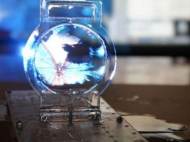Colloidal Display – a soap bubble transparent display
 Many research groups around the world are developing new ways to present media and improve information interaction, ranging from images projected onto fog to various solutions regarding holography, but an international team of researchers managed to produce Colloidal Display – a display that uses ultrasonic sound waves to alter soap film’s properties in order to project 2D or 3D images onto its surface.
Many research groups around the world are developing new ways to present media and improve information interaction, ranging from images projected onto fog to various solutions regarding holography, but an international team of researchers managed to produce Colloidal Display – a display that uses ultrasonic sound waves to alter soap film’s properties in order to project 2D or 3D images onto its surface.
“It is common knowledge that the surface of soap bubble is a micro membrane. It allows light to pass through and displays the color on its structure”, said Dr Yoichi Ochiai, from the University of Tokyo who leads the research. “We developed an ultra-thin and flexible BRDF screen using the mixture of two colloidal liquids.”
BRDF screen stands for Bidirectional Reflectance Distribution Function screen and it represents a four-dimensional function defining how light is reflected at an opaque surface. Unlike traditional opaque, the display created by Dr Ochiai and his colleagues Keisuke Toyoshima from the University of Tsukuba in Japan, and Alexis Oyama from the Carnegie Mellon University in the USA, varies in transparency and reflectance.
Unlike soap bubbles most of us had the chance to play with, the bubble mixture used in this research is more complex and it includes mixture of colloids which are hard to pop. As you can see in the first video, you can even poke the bubble screen without making it burst. Although this feature could be used to increase interactivity with future displays relying on ultrasonic technology, you can notice some of the sounds the machine makes, and I’m pretty sure that your pets which can register higher frequencies won’t be too happy around these displays if they aren’t soundproofed.
The properties of this mixture can be exploited with usage of ultrasonic sound waves played through speakers. Once these waves hit the bubble surface, they manage to change its texture and make it appear like the texture of the projected image.
Transparency and reflection of the bubble can also be controllable. To change the transparency of the projected image, the scientists modified the frequency of ultrasonic waves. When you combine all these features with several bubble screens, viewers can enjoy in 3D effects or even a holographic projection.
“Our membrane screen can be controlled using ultrasonic vibrations. Membrane can change its transparency and surface states depending on the scales of ultrasonic waves”, said Dr Ochiai. “The combination of the ultrasonic waves and ultra thin membranes makes more realistic, distinctive, and vivid imageries on screen.”
If several bubble screens are put together, viewers get a 3D effect and even a holographic projection. Colloidal displays could be used by artists to provide a realistic feel to their works, or for entertainment purposes and interesting information interaction solutions.









Looks awesome, but you’re right… my dog didn’t like the sound from the video.